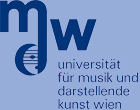List of Vienna Talk 2010 presenters

Amir, Noam
(P,O)Andermann, Martin
(P)Arzt, Andreas
(O)Bastos, Patricia Lopes
(P)Beauchamp, James Warren
(O,O)Bendl, Ingrid
(P)Bertsch, Matthias
(P)Bisesi, Erica Elisabetta
(O)Buen, Anders
(O)Campbell, Murray
(O)Cano, Estefania
(P)Carral, Sandra
(P)Carter, Stewart Arlen
(O)Chatziioannou, Vasileios
(P)Chick, John
(O)Curtit, Marthe
(O)Dalmont, Jean-Pierre
(O)Davidenkova, Ekaterina
(O)Presentation type: Oral / Invited
History of electro-musical instruments in Russia, first half of 20th Century
Analysis of electro-musical instruments development history in Russia presented in this paper shows that the period from 30s to 70s of 20th century characterized by great interest of acoustics scientists and engineers to produce a new generation such instruments. First instrument was "Thereminvox" (1919) authored by outstanding Russian engineer L.S. Termen, who was continually working throughout many years to invent instruments of new generation: “Terpsitone”, “Rhythmicon”, “Harmonium” and others. New series of other electro- musical instruments came up after that: in 1924 V.A. Gurov and V.I. Volynkin built monodic neck- rheostatic instrument named “Violena”; in 1925 S.N. Rzhevkin created polyphonic keyboard instrument “Cathoodic Harmonium”; by 1935 A.A. Volodin engineered series of keyboard-necked instruments “Ekvodin”. In 1937 I.D. Simonov represented keyboard instrument “Companola” and in 1944 A.V. Rimsky-Korssakov, V.A. Kreytser, A.A. Ivanov produced keyboard electro- musical instrument “Emiriton”. In 1955 S.G. Korssunsky invented harmonium “Kristadin” and in 1958 same I.D. Simonov engineered piano with electronic sound driver. First analogue synthesizer (ANS), served as prototype for following instruments of this type, was engineered by E.A. Murzin in 1938-1957. Based on unique method of optical generation of pure sounds with following photoelectrical reading of signals,the ANS combined process of sounds generation, recording and playback of sounds by means of painting on the glass. With 72nd degree scale temperament, 10 octaves sounding range ANS let composer use all frets and tone scales, noises and unlimitedly alter timbres.

Demoucron, Matthias
(O)Doutaut, Vincent
(P)Dörfler, Monika
(O)Flossmann, Sebastian
(O)Fouilhe, Eric
(O)Fricke, Jobst P.
(O)Fritz, Claudia
(O)Gingras, Bruno
(O)Goebl, Werner
(P)Granzotto, Nicola
(P)Grosshauser, Tobias
(O)Guettler, Knut
(O)Hansen, Uwe J
(O)Kartofelev, Dmitri
(P)Kausel, Wilfried
(P)Kemp, Jonathan
(O,O)Klaus, Sabine Katharina
(O)Kostek, Bozena
(O)Lambrechts-Douillez, Jeannine
(O)Lohri, Angela
(P)Marchand, Sylvain
(O)Mayer, Alexander
(P)Moore, Thomas
(O,O)Morrison, Andrew
(O)Myers, Arnold
(O)Nederveen, Cornelis J
(O)Niedermayer, Bernhard
(O)Norman, Lisa
(O)Oehler, Michael
(O)Otcenasek, Zdenek
)Pyle, Robert W.
(O,O)Reuter, Christoph
(O)Richardson, Bernard
(P,O)Rose, Maria
(O)Rossing, Thomas D.
(O,O)Sanchez, Monica
(P)Schoonderwaldt, Erwin
(O)Sharp, David
(O)Siddiq, Sadjad
(P)Skala, Jan
(P)Smith, Richard
(O)Sundberg, Johan
)Taylor, Crissman
(O)Tronchin, Lamberto
(O)Tsai, Pei Ju
(P)Vereecke, Hannes William
(P)Vergez, Christophe
(O)Widmer, Gerhard
(O)Worland, Randy
(O)Ziegenhals, Gunter
(O)van der Linden, Janet
(O)





